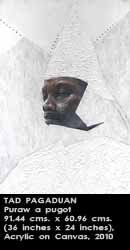Images of women and their stories have been an enduring theme in contemporary arts. Even our national artists have engaged in spotlighting the femme figure with outstanding artworks now revered by national and international art aficionados. Cases in point are the maidens as painted by National Artist for the Visual Arts Fernando Amorsolo whose masterpieces provide more than visual historiography. His canvases have stamped themselves in the popular mind evoking the tranquil long-ago in a rustic paradise. His women are of rounded faces with lively eyes and bronze skin gleaming in the daylight. Amorsolo’s works are very noteworthy in the development of our own Filipino identity and aesthetic.
Societal conditions and socio-political issues in the ‘60s and the currents of political change which swept our country in the ‘70s and ‘80s have steadily altered the Philippine aesthetic landscape. As men have dominated the Philippine art scene, gender and its issues fought its way to be recognized as an important aspect not only in social relations and economic access. The conservative notions of gender suppressed our female identity and detained women within the bounds of typecast functions and expectations into which we are socialized.
Herstory as a neologism coined in the late 1960s sprouted as part of a feminist critique of conventional historiography. Defining itself from history (as his-story), the discourse advocated a feminist standpoint with emphasis on the position of women or conveyed from a female’s point of view.
Such that as early as in 1951 Kate Aitken wrote, “Just as women are exercising greater power and influence both nationally and internationally, so must they accept greater responsibility. This is no longer a man's world, but one world in which both men and women must cooperate in making it fit for the present and coming generations.”
A solo exhibition of paintings being mounted by Sigwada Gallery, Baguio City-based visual artist Ernie Gomez showcases “Bab-ba-i.” An Ilocano term for “women,” the female figure has always been the central theme of Gomez’s works.
What sets him apart from his contemporaries at the Cordillera is that his women are presented not in their customary cultural finery. Rather a representation that focuses on the correlation between earth and women based on their productive and creative functions. The series of paintings executed in acrylic on both paper and canvas articulates Gomez’s rendering of the continuing relationship between women and the earth. It is introspective from a male artist’s point of view and depiction.
As an artist, Gomez is excited to be part of this consciousness of the feminine contribution and the re-balancing of feminine and masculine energies on this level. His paintings elucidate women's internal intrinsic power to generate the certainties she desires to experience. This interlocking connectedness of women, nature and the contiguous world, directs the artist’s comprehension of what is within himself and how he fits into the totality.
Bab-ba-i, the Ernie Gomez one-man exhibition is curated by JCrisanto Martinez. The exhibition opens at the Sigwada Gallery on January 5, 2011 at 6:00 p.m. and shall be on view until January 26, 2011. The gallery is located at 1921 Oroquieta St., Sta. Cruz, Manila, Philippines. For further inquiries about the Ernie Gomez’s paintings and the exhibition, please contact Cecile Pagaduan-Ochoa at (632) 7435873, thru sms at (+63) 9178075659, thru email at info@sigwadagallery.tk or visit the website www.sigwadagallery.tk.
Texts by JCrisanto Martinez
Images by Ernie Gomez
























